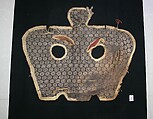Shaffron (Horse's Head Defense)
Not on view
This shaffron is extraordinarily rare both for being one of only a few known examples of Central Asian textile shaffrons (see also 2016.171) and for the fact that it is a largely intact and complete textile object from a region and period when textile fragments are the norm. The weaving technique and the motifs suggest that the silk was made in Central Asia, inspired by Chinese fabric that was known via commerce on the Silk Road.
A ceremonial shaffron (horse's head covering) made of silk. The shaffron has two circular eye openings. At the center of the top edge there is a poll piece in the form of a tab that would lay between the ears on the horse's poll. Along the bottom edge there are two notches to accommodate the nostrils. There are separately padded crescent-shaped pieces above the eyes and above the nostril areas. The main textile is dark purple-brown with a repeating pattern of closely grouped and slightly offset horizontal rows of rondels. The pattern consists of three rows of motifs: row 1, a trefoil design; row two, a circle of dots around a central crescent; row 3, a circular blossom. The rows alternate in the following sequence: 2, 1, 3, 1, 2, 1, 3, 1, etc., from top to bottom in 18 full rows, with partial rows above and below. The outer edges of the entire shaffron, the edges of the eye openings, and the outer edges of the eyebrows and nostrils are trimmed with an unpatterned tan silk border. The reverse is covered with plain reddish-brown silk. The interior is stuffed with a felted animal fiber that may have been intended to serve as padding or insulation. There are remains of leather tabs or trim on the proper upper left of the poll tab. The shaffron was tied on with at least four laces that were stitched to the outer edges of the reverse: a portion of one lace and the attachment points for three others remain.
Due to rights restrictions, this image cannot be enlarged, viewed at full screen, or downloaded.

